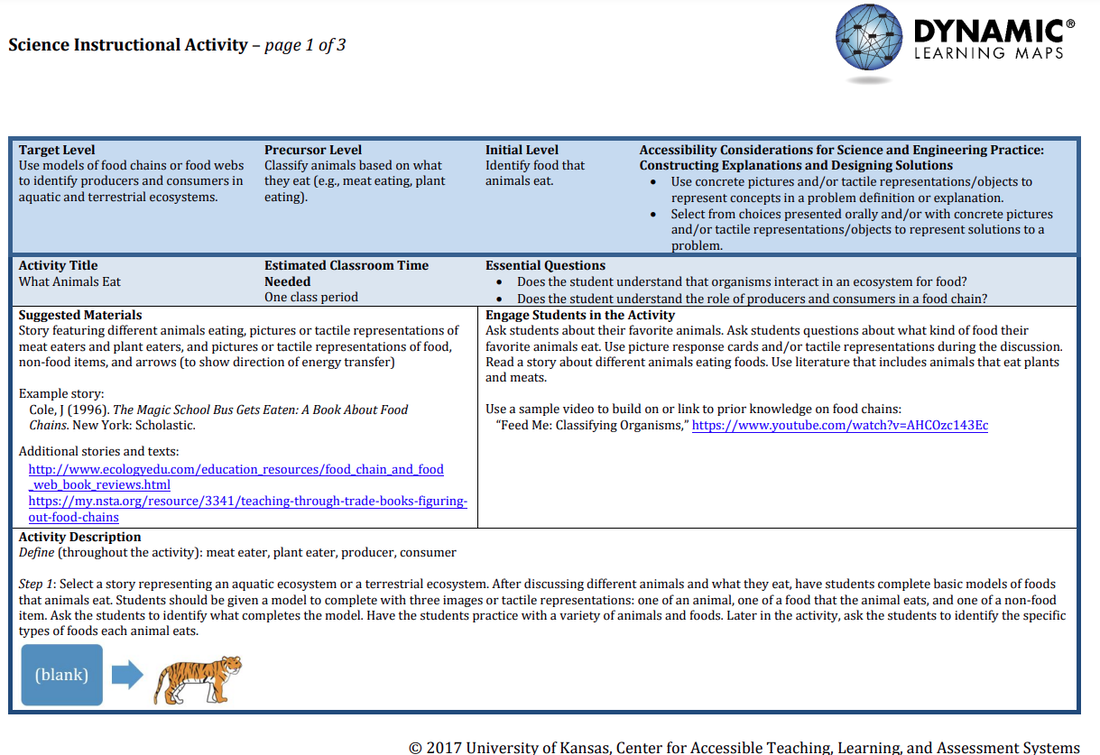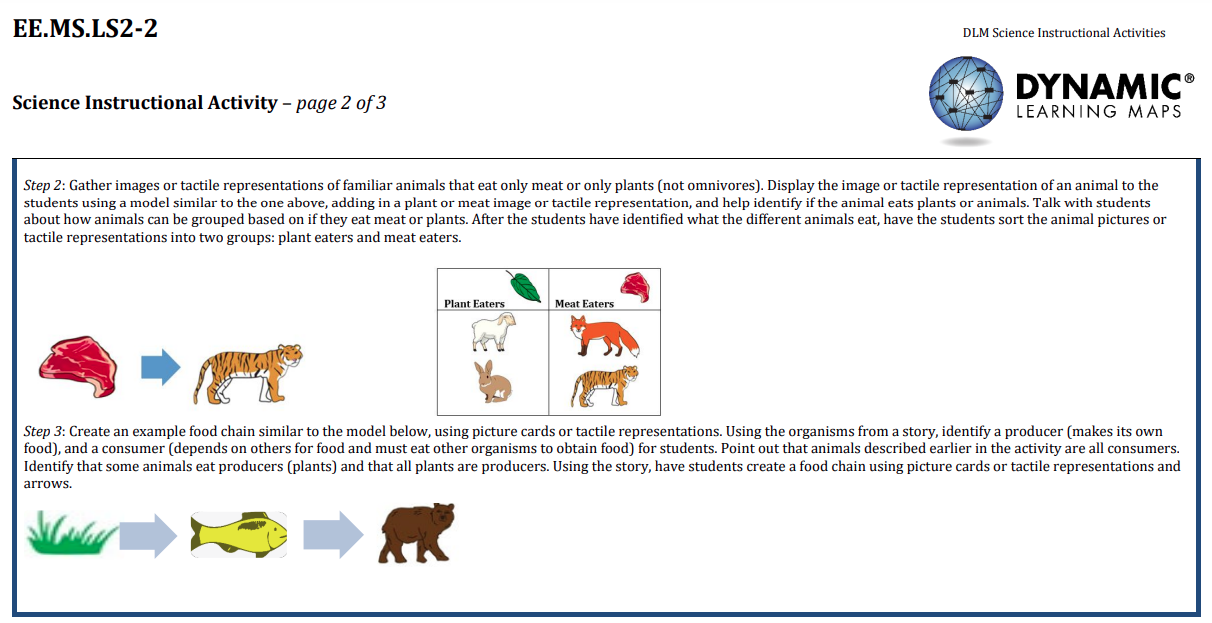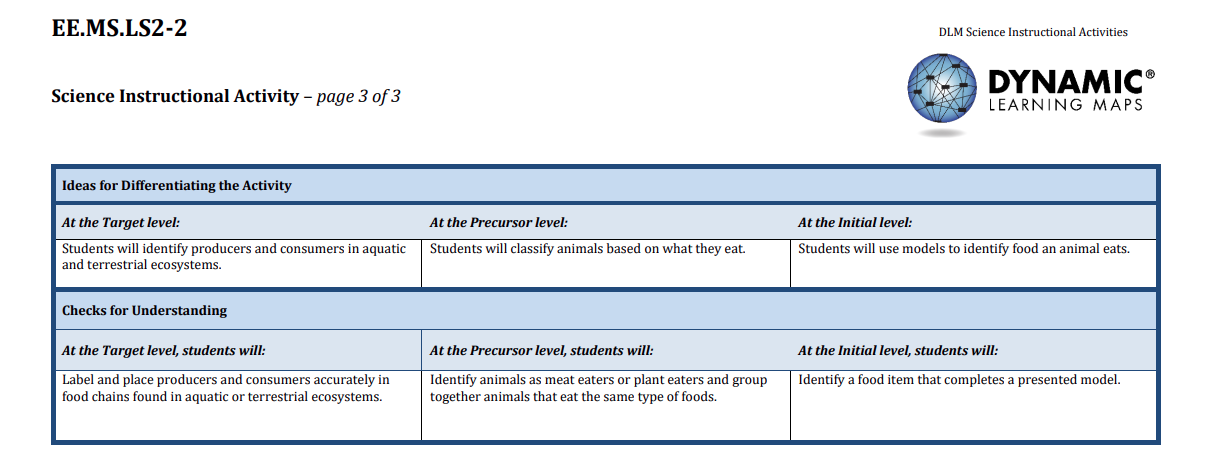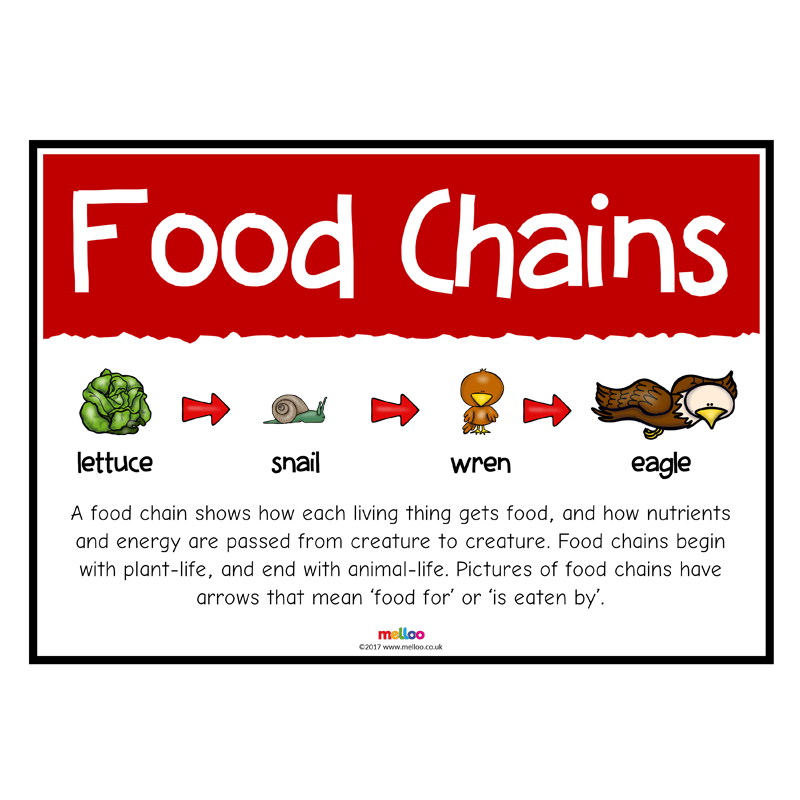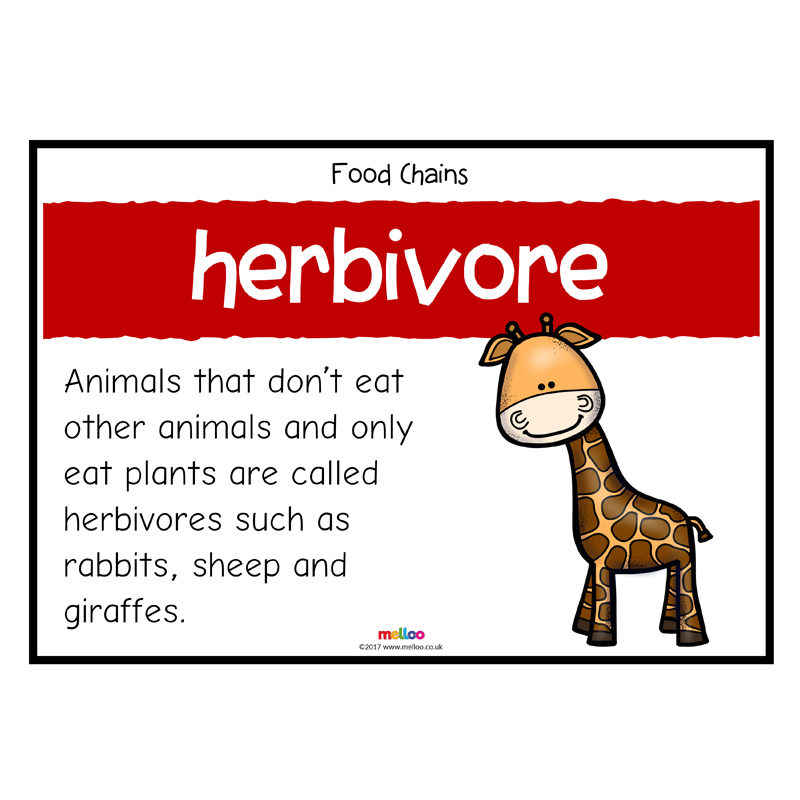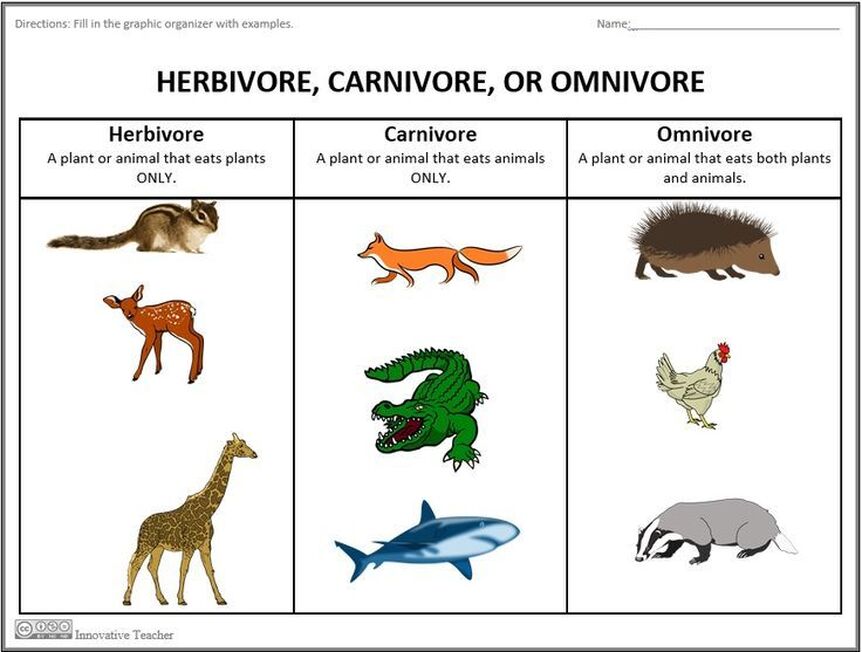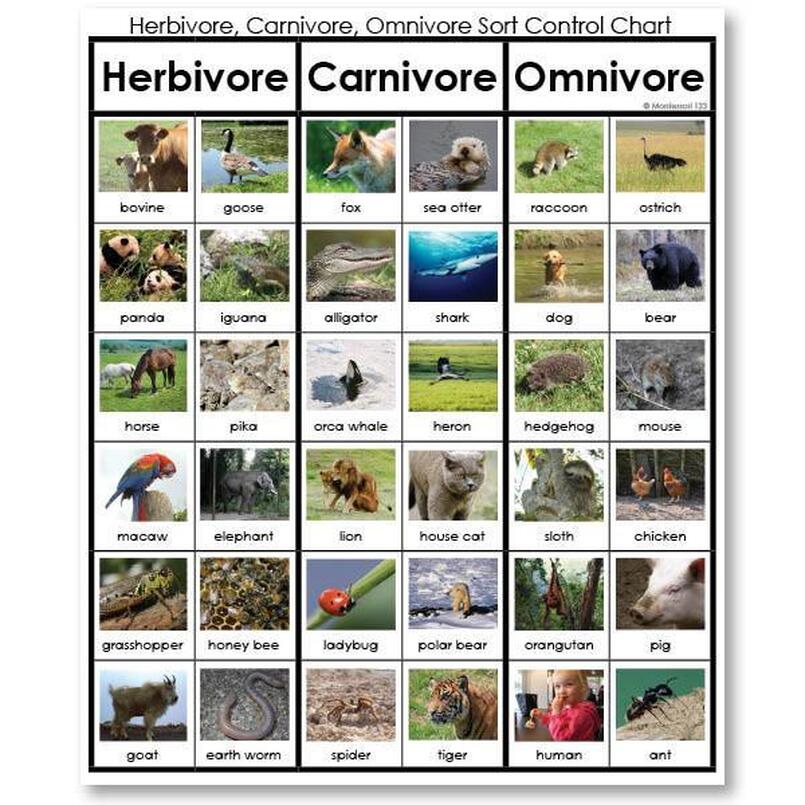Essential Element: EE.MS-LS2-2
This is a DLM tested standard.
Target Level: Use models of food chains/webs to identify producers and consumers in aquatic and terrestrial ecosystems.
Precursor Level: Classify animals based on what they eat (e.g., herbivore, omnivore, carnivore).
Initial Level: Identify food that animals eat.
Precursor Level: Classify animals based on what they eat (e.g., herbivore, omnivore, carnivore).
Initial Level: Identify food that animals eat.
Links from above document:
Trophic Efficiency & Ecological Pyramids: Definition & Examples
Ecological Pyramids Biology for All FuseSchool-Urdu
dynamiclearningmaps.org/sites/default/files/documents/Science/SCI_EEs/SCI.EE.MS-LS2-2_activity.pdf
Trophic Efficiency & Ecological Pyramids: Definition & Examples
Ecological Pyramids Biology for All FuseSchool-Urdu
dynamiclearningmaps.org/sites/default/files/documents/Science/SCI_EEs/SCI.EE.MS-LS2-2_activity.pdf
Vocabulary
- producers
- consumers
- herbivore
- omnivore
- carnivore
- food chain
Books Related to Topic
Reading A-Z
Food Chains and Food Webs
"The book Food Chains and Food Webs helps readers explore how living things are interconnected. It classifies organisms in several ways based on how they receive the matter and energy they need to grow, live, and perform activities. Organisms can be described as producers, consumers, or decomposers. Special species such as scavengers and parasites also play an important role in ecosystems. The book introduces food chains, food webs, and energy pyramids as graphical devices that can be used to demonstrate connections within an ecosystem. By visualizing the interconnectedness of species within an ecosystem, one can observe and understand population patterns, competition, and why each species has the adaptations it does. Finally, the book explains natural and human-caused ways that ecosystems can change."
Food Chains and Food Webs
"The book Food Chains and Food Webs helps readers explore how living things are interconnected. It classifies organisms in several ways based on how they receive the matter and energy they need to grow, live, and perform activities. Organisms can be described as producers, consumers, or decomposers. Special species such as scavengers and parasites also play an important role in ecosystems. The book introduces food chains, food webs, and energy pyramids as graphical devices that can be used to demonstrate connections within an ecosystem. By visualizing the interconnectedness of species within an ecosystem, one can observe and understand population patterns, competition, and why each species has the adaptations it does. Finally, the book explains natural and human-caused ways that ecosystems can change."
Epic Reading
Why Do Animals Eat Each Other - Video
Animals are cute, so why do they eat each other? Find out on Science Mysteries Revealed!
Who Eats What? Ocean Food Chains - text
Explore the ocean biome and the food chains it supports.
Who Eats What? Arctic Food Chains - text
Explore the Arctic biome and the food chains it supports.
Who Eats What? Rain Forest Food Chains - text
Explore the rain forest biome and the food chains it supports.
Search in Epic "food web" to get more text options!
Why Do Animals Eat Each Other - Video
Animals are cute, so why do they eat each other? Find out on Science Mysteries Revealed!
Who Eats What? Ocean Food Chains - text
Explore the ocean biome and the food chains it supports.
Who Eats What? Arctic Food Chains - text
Explore the Arctic biome and the food chains it supports.
Who Eats What? Rain Forest Food Chains - text
Explore the rain forest biome and the food chains it supports.
Search in Epic "food web" to get more text options!
Education.com
Search Food Web for a workbook if you are a member.
Food Webs | Workbook | Education.com
Search Food Web for a workbook if you are a member.
Food Webs | Workbook | Education.com
Food Chain
A food chain is the order of how one living thing eats and gets energy from another living thing.
A food chain shows how plans and animals rely on each other for food.
A food chain shows how plans and animals rely on each other for food.
https://melloo.co.uk/media/catalog/product/cache/1/image/9df78eab33525d08d6e5fb8d27136e95/f/o/food-chains-ks-resource-3_1.png
https://www.coolaboo.com/wp-content/uploads/2020/05/food-chain-2.jpg
Your browser does not support viewing this document. Click here to download the document.
Producer
Producers are living things that can make their own food.
Consumer
Consumers are living things that eat plants and animals.
Your browser does not support viewing this document. Click here to download the document.
Herbivore
An herbivore is an animal that only eats plants. You can find herbivores like deer, squirrels, and butterflies.
https://melloo.co.uk/media/catalog/product/cache/1/image/9df78eab33525d08d6e5fb8d27136e95/f/o/food-chains-ks-resource-2_1.png
Carnivore
A carnivore is an animal that only eats other animals, like wolves, praying mantises, and eagles.
Omnivore
Some animals eat both plants and other animals. They’re called omnivores. Red foxes eat some fruits, like berries and apples, but they also eat amphibians and fish. Blue jays eat seeds and acorns, but they also eat worms and even baby birds!
Aquatic Ecosystem
An aquatic ecosystem is an ecosystem in a body of water.
Terrestrial Ecosystem
A terrestrial ecosystem is a type of ecosystem found only on land forms.
Six primary terrestrial ecosystems exist:
1. tundra
2. taiga
3. temperate deciduous forest
5. tropical rain forest
5. grassland
6. deserts
Six primary terrestrial ecosystems exist:
1. tundra
2. taiga
3. temperate deciduous forest
5. tropical rain forest
5. grassland
6. deserts
https://i.pinimg.com/originals/bb/83/cf/bb83cfbc4923c433eb01565daaade208.jpg
https://cdn.shopify.com/s/files/1/0114/5092/products/zoology-sorting-games-herbivore-carnivore-or-omnivore-sorting-cards-2_600x600.jpg?v=1568665543
Nutrition, an interactive worksheet by elizabeth_king
liveworksheets.com
liveworksheets.com
Eating Habits, an interactive worksheet by MaryE
liveworksheets.com
liveworksheets.com
Let's Eat- Sort animals, an interactive worksheet by econnolly2
liveworksheets.com
liveworksheets.com
Food Chain interaction, an interactive worksheet by LauraSancho
liveworksheets.com
liveworksheets.com
Food chain, an interactive worksheet by IndhuMS
liveworksheets.com
liveworksheets.com
Games
www.sheppardsoftware.com/science/animals/games/animal-diet/
www.sheppardsoftware.com/science/animals/games/animal-diet-2/
www.sheppardsoftware.com/science/animals/games/producers-consumers/
www.sheppardsoftware.com/science/animals/games/food-chain/
Games : Feed the Dingo . PLUM LANDING | PBS KIDS
Games : Make a Mangrove . PLUM LANDING | PBS KIDS
www.sheppardsoftware.com/science/animals/games/animal-diet-2/
www.sheppardsoftware.com/science/animals/games/producers-consumers/
www.sheppardsoftware.com/science/animals/games/food-chain/
Games : Feed the Dingo . PLUM LANDING | PBS KIDS
Games : Make a Mangrove . PLUM LANDING | PBS KIDS
